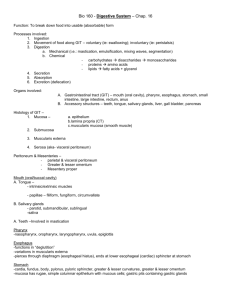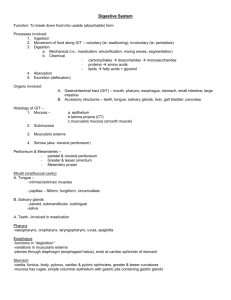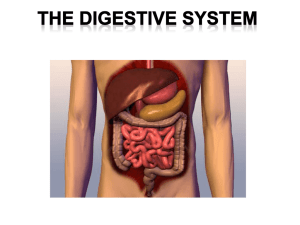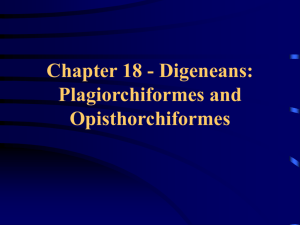Digestive System
advertisement
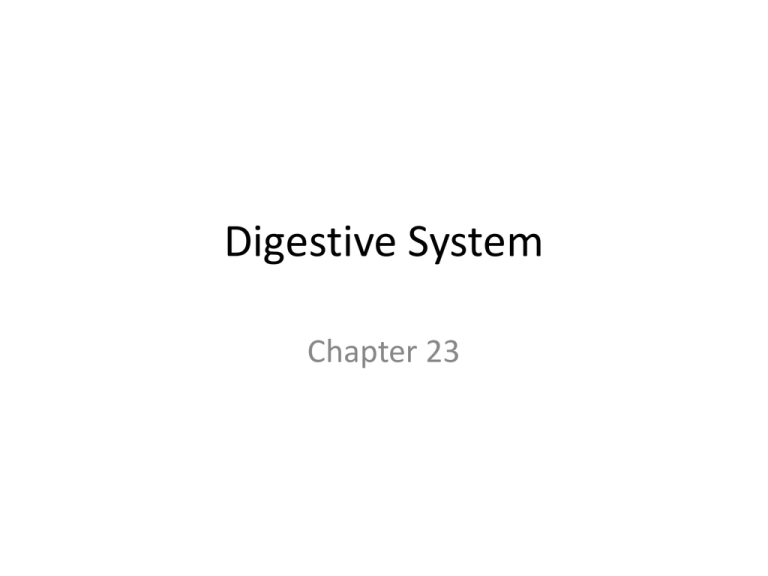
Digestive System Chapter 23 Overview • Alimentary canal or gastrointestinal (GI) tract • Accessory digestive organs • Food moved by peristalsis • Regulated by sphincters • Processing time varies Digestive Processes • Ingestion: act of eating • Propulsion: moving food through GI tract – Deglutition and peristalsis • Digestion: break down of food – Mechanical uses chewing, mixing, and churning – Chemical uses enzymes • Absorption: nutrients, vitamins, minerals, and H2O into blood • Defecation: elimination of undigested materials Peritoneum • Serous membrane of the abdominal cavity – Review: what are components? – Mesenteries fuse parietal to visceral • Routes for vascular, lymph, and nervous supply to viscera • Holds organs in place and stores fat • Retroperitoneal organs lie outside peritoneum – Includes pancreas, kidneys, parts of large intestine • Intraperitoneal organs stay w/i cavity – Includes stomach, small and parts of large intestine, liver http://www.vivo.colostate.edu/hboo ks/pathphys/misc_topics/peritoneu m.html • Blood supply – Celiac trunk and mesenteric arteries to digestive viscera – Hepatic portal to liver for storage and processing Basic Histology • 4 tunics line entire GI tract – Mucosa from mouth to anus • Epithelium is simple columnar w/goblet cells • Lamina propria is areolar CT a nd MALT (chpt 20 review) • Muscularis mucosae is smooth muscle – Submucosa • Areolar CT, blood, lymph, and nerves – Muscularis externa • Smooth muscle in circular (inner) and longitudinal (outer) layers – Serosa (visceral peritoneum) • Areolar CT w/ simple squamous layer • Predominant tissue type facilitates processing role • Fig 23.6 Oral Cavity: Mouth • Stratified squamous epithelium • Lips (orbicularis oris) and cheeks (buccinators) – Mastication and forming words/pronunciation • Palate – Hard (palatine process of maxilla and palatine bones) – Soft (skeletal muscle) with hanging uvula • Tongue (skeletal muscle) – Food manipulation (bolus), taste, and speech production – Tastebuds • Filiform papillae: not tastebuds, roughen tongue surface • Fungiform papillae: mushroom shaped w/ tastebuds on top • Circumvallate papillae: circular w/tastebuds on sides Oral Cavity: Salivary Glands • Parotid, submandibular, sublingual, and buccal – Serous and mucus cells produce saliva components • Saliva – Lysozymes, IgA, and defensins cleanse and protects mouth from microorganisms – Mucin and water (97 – 99%) to moisten and dissolve food – Salivary amylase breaks down carbs • Control – Intrinsic continuously secrete to keep mouth moist – Extrinsic in response to food; sight, smell & thought too – SNS inhibits causing dry mouth, xerostomia • Halitosis and caries from food particles accumulating and bacteria flourishing Oral Cavity: Teeth • Chew, tear and grind food to initiate breakdown • Deciduous, or milk teeth, form 1° dentition (20) • Permanent teeth from permanent dentition (32*) – Types • • • • Incisors cut and nip (8, 2 pairs top and bottom) Canines tear and pierce (4, 1 pair top and bottom) Premolars grinding and crushing (8, 2 pairs top and bottom) Molars see premolars (12, 3* pairs top and bottom) – Dental formula • (__I x __C x __M / __I x __C x __M) x 2 = • Impacted teeth when remain in jaw Oral Cavity: Teeth (cont.) • Crown exposed above gingiva – Covered in enamel, hardest material in body • No mitotic activity to fix cracks and decay • Overlays bone-like dentin • Root anchored in jaw by periodontal ligament – Gomphosis in alveolar margin – Number varies by tooth type and location – Covered in cementum, calcified CT • Pulp cavity become root canal w/ apical foramen – Damage to nerve and blood supply facilitates infection – Root canal therapy to sterilize before filling Tooth and Gum Disease • Caries or cavities when enamel and dentin decay – Dental plaque adheres and acidity increases • Ca2+ salts removed, organics dissolved by bacteria • Brushing and flossing daily prevent – Calculus, or tarter causes gingiva separation • Gingivitis, an early indication, causes bleeding and swelling • Periodontal disease when calculus untreated – Immune system attacks bacteria and periodontal ligaments – Osteoclast activity increased • Research links w/increase risk of heart attack and stroke Pharynx • Oropharynx laryngopharnx – Food and fluids to esophagus – Air to trachea • Lined w/ stratified squamous and goblet cells • Skeletal muscle layers for swallowing – Inner longitudinal – Outer circular pharyngeal constrictors Esophagus • Laryngopharynx esophageal sphincter esophageal hiatus cardiac orifice gastroesophageal sphincter – Heartburn when GE sphincter not tightly closed/leaks • Histology – Mucosa w/ strat. squ. sim. colum. • Folds w/o food that flatten w/ food – Submucosa w/ mucus glands to aid passage – Muscularis externa w/ skeletal skeletal & smooth smooth – Fibrous CT fibrous adventitia instead of serosa Mouth to Esophagus Digestion • Mouth ingests – Mastication uses teeth and tongue to start mechanical digestion • Food and structure mov’t influences – Salivary amylase starts chemical digestion of carbs • Tongue forms bolus for deglutition – Tongue pushes to oropharynx in buccal phase (voluntary) • Esophageal sphincter constricts – Pharyngeal-esophageal phase (involuntary) • Uvula and epiglottis protection triggered • Esophageal sphincter relaxes • Peristalsis moves bolus down esophagus – Gastroesophageal spincter relaxes then constricts – Prevents chyme escape Stomach • Chemical breakdown of proteins • Regions – – – – Cardia Fundus Body Pyloric region (antrum, canal, and sphincter) • Mesenteries (greater and lesser omentums) at respective curvatures • Rugae seen when empty, allow distension Stomach: Microscopic Anatomy • Muscularis externa w/ 3rd oblique layer to break food and push to SI • Mucosa – Simple columnar epithelia w/ goblet cells • Insoluble alkaline mucus layer w/ bicarbonate fluid below • Protects stomach from acid and enzyme digestion – Invaginates into gastric pits leading to gastric glands that produce gastric juices, mucus, and gastrin • Pits are primarily mucus cells • Glands vary w/ region Gastric Glands • Mucus neck cells produce acidic mucus – Function not understood • Parietal cells secrete H+ and Cl- ions HCl – Acidity (pH ~ 2) denatures proteins, kill bacteria, and digest cellulose – Intrinsic factor production: B12 absorption for RBC production • Chief cells produce pepsinogen pepsin • HCl initiates, but pepsin maintains (positive feedback) • Enteroendocrine cells release chemical messengers – Histamine, gastrin, serotonin, endorphins, cholecystokinin (CCK), and somatostatin Protecting the Stomach • • • • • • Insoluble mucus layer on surface Bicarbonate ions (HCO3-) Tight junctions b/w epithelial cells H+ and Cl- ions secreted separately Epithelial replaced ~ 3 – 6 days Gastric ulcers form when mechanisms fail – Chronic can rupture stomach – Helicobacter pylori usually responsible Controlling Gastric Secretion • Cephalic (reflex) phase before food entry – Smell, taste, thought, or sight excites – Depression or lack of appetite suppress • Gastric phase once food enters stomach – Stretch receptors signal ACh to increase gastric juices – Peptides, caffeine, and high pH stimulate gastrin (HCl) release – Low pH, emotions, and SNS inhibit gastrin • Intestinal phase once food enters duodenum (SI) – W/ low pH and food stimulates intestinal gastrin release – Distension and prolonged low pH inhibit CN X, activate SNS to tighten pyloric sphincter, and release inhibiting hormones • Fig 23.17 Controlling Mobility and Emptying • Peristalsis pushes to pyloric for mixing before retropulsion pushes back – Chyme squirts through pyloric valve w/ each cycle • Duodenum monitoring tightly coupled – Inhibiting hormones from intestinal phase (previous) – Carb rich chyme moves quickly, but fat rich chyme slower for digestion • Vomiting or emesis • Fig 23.30 Small Intestine (SI) • Digestion finishes and nutrient absorption occurs • 3 subdivision w/ no clear external distinctions – Duodenum (retroperitoneal) • Receives chyme from pyloric sphincter • Hepatopancreatic ampulla where bile and pancreatic duct join (sphincterof Oddi controls) – Jejunum (mesentery support) – Ileum (mesentery support) • Ileocecal valve at LI junction Small Intestine: Microscopic Anatomy • Mucosa and submucosa form plicae circulares – Simple columnar mucosa folds into villi • Lacteal, artery, and vein w/i • Intestinal crypts b/w – Intestinal juice, Paneth cells, and new cells – PM of mucosa cells form microvilli (brush border) • Enzymes finalize carb and protein digestion – Increase SA for absorption • Submucosa variations throughout SI region – – – – Intestinal crypts decrease Goblet cell number increases Peyer’s patches (MALT) increase Brunner’s glands (HCO3- mucus) in duodenum only • Muscularis externa – Duodenum w/ adventitia (retroperitoneal) Liver • Right, left, caudate, and quadrate lobes – Falciform ligament is the mesentery • Separates R & L and suspends liver from diaphragm – Ligament teres is remnant of umbilical vein • Lesser omentum connects curvature to liver – Hepatic artery, vein, and portal vein • Hepatic ducts hepatic duct common bile duct • Hepatitis and cirrhosis Liver: Microscopic Anatomy • Hexagonal liver lobules are functional units – Hepatocytes arranged around a central vein • Portal triads at each corner • Bile duct, hepatic artery, and hepatic portal vein • Liver sinusoids (capillaries) b/w – Kupffer cells Gallbladder • Stores and concentrates liver produced bile – Hepatic duct cystic duct storage – Cystic duct common bile duct sphincter of Oddi release • Bile – Alkaline solution to emulsify lipids – Facilitate fat and cholesterol absorption – Bile salts recycled in illeum back to liver (hepatic portal vein) – Bilirubin, chief pigment, absorbed in liver and released in bile • Gallstones from cholesterol crystallization • Jaundice when bile pigments accumulate in skin from blockage Pancreas • Retroperitoneal organ • Acinar cells produce digestive enzymes that breakdown all foodstuffs – Pancreatic duct joins common bile to drain to duodenum (where specifically?) • Islets of Lagerhans produce insulin and glucagon Pancreatic Juice • Water based solution of enzymes and HCO3– Neutralize chyme (pH ~ 2 vs pH ~ 8) – Optimal pH for enzymes • Enzymes hydrolyze monomers – Inactive proteases – Active amylases, lipases, and nucleases Accessory Secretion Regulation • Neural (CN X) and hormonal (CCK & secretin) control • CCK released w/ fatty chyme presence • Gallbladder contract and sphincter of Oddi relax – Vagus nerve weakly • Bile and pancreatic juice (enzyme rich) secreted • Secretin released w/ HCl presence – HCO3- rich pancreatic juice release • Bile salt presence stimulates more bile release – Positive feedback Large Intestine • Absorb water & vitamins and eliminate feces • Tone of teniae coli create pouch-like haustra • Divisions – Cecum – Appendix (MALT) • Appendicitis when blocked and bacterial growth – – – – Ascending and descending colon are retroperitoneal Transverse and sigmoid colon w/ mesocolons Rectum w/ rectal valves to separate feces and gas Anal canal w/ internal and external sphincters • Imbalances – Diarrhea vs constipation Large Intestine: Microscopic Anatomy • Mucosa – Simple columnar except anal canal (strat. squa.) – No folds, villi, or digestive enzyme cells – Thicker w/ deeper crypts and more goblet cells • Bacterial flora – Enter via anus or survive SI – Functions • Breakdown indigestible carbs (cellulose) • Release gases from breakdown • Synthesize vitamins B and K – Generally peaceful existence • Irritable bowl syndrome (disease) when not Nutrient Digestion • Catabolic process of hydrolysis • Carbohydrates – Amylases (salivary and pancreatic) – Brush border enzymes (dextrinase, lactase, maltase, sucrase) – From villi to liver in hepatic portal vein • Proteins – Pepsin in stomach (pepsinogen + HCl) – Brush border peptidases (amino-, carboxy-, di) – Pancreatic proteases (trypsin, chymotrypsin, carboxypeptidase) • Lipids – Bile sales emulsifies fats to expose triglycerides – Pancreatic lipase forms glycerol and FA’s • Nucleic acids – Brush border enzymes (nuclesidases and phosphotases) – Pancreatic nucleases (deoxy- and ribonucleases) • Fig 23.32 Nutrient Absorption • Carbohydrates – Glu and gal: active transport (w/ Na+) to epithelium then facilitated diffusion to capillaries – Fru: only facilitated diffusion • Proteins – See glucose and galactose above – Inefficient in newborns = food allergies as endocytized whole proteins ‘seen’ as antigens; allow IgA from breast milk into blood • Lipids – Monomers bind w/ bile salts = micelles to reach epithelium for diffusion – Chylomicrons in epi. when reassembled water soluble lacteal absorb • Nucleic Acids – See glucose and galactose above Nutrient Absorption (cont.) • Vitamins – Fat soluble see lipids previous; need to eat w/ – Water soluble by diffusion, active, or passive transport • Electrolytes – Anions move w/ Na+ gradient (glucose & glactose) – Iron and Ca2+ regulated by body needs – K+ related to water volume/absorption • Water – 95% in SI, rest in LI – Bidirectional, but net osmosis w/ [gradient] from active solute absorption
